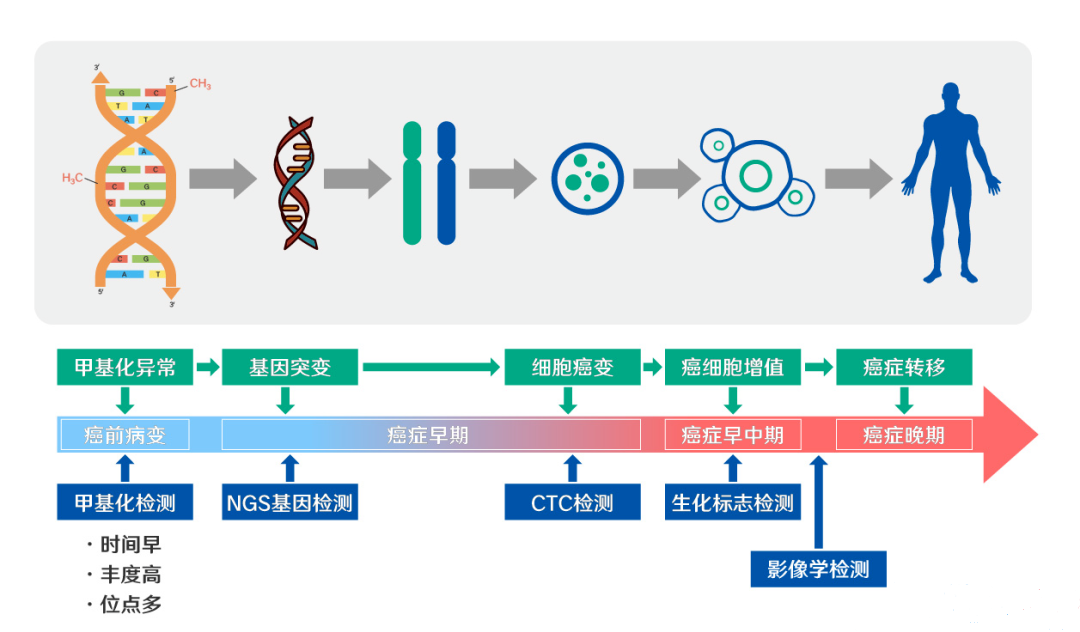2023-12-15
Science Popularization | Age of Early Screening for Cancer - Principles and Sign
Currently, most cancers are usually in their advanced stages when discovered, and although some targeted drugs can be used for treatment, aside from their high cost, their efficacy is also limited.
Therefore, if early diagnosis can be achieved, it will greatly reduce the incidence rate of cancer and improve the survival rate of patients. However, at present, most hospital clinical guidelines only recommend common screening methods for a small number of people with lung cancer, breast cancer, colorectal cancer, cervical cancer and other cancers.
With the development of sequencing technology, many new methods have been applied in various early cancer screening, such as detecting circulating tumor cells in the blood or circulating tumor cell free DNA (cfDNA) and circulating tumor cell DNA (ctDNA).

Related data on various types of early screening products for cancer abroad
The relationship between DNA methylation and tumors
DNA methylation detection can not only be used for early disease screening, but also to determine an individual's response to chemotherapy. In recent years, it has gained increasing attention in the tumor early screening industry. So what exactly is DNA methylation? What's the use of it?
Circulating tumor DNA (ctDNA) is a type of circulating free DNA (cfDNA) in the bloodstream. As a research focus in the field of tumor detection in recent years, it has important application value in non-invasive early screening of tumors.

Characteristics of ctDNA
DNA methylation is a form of DNA chemical modification, which refers to the process in which DNA molecules selectively add methyl groups to specific bases under the action of DNA methyltransferase. DNA methylation can alter genetic expression without altering DNA sequence, and is one of the most important epigenetic regulatory mechanisms.

DNA methylation
From the perspective of DNA methylation, the main difference between tumor cells and normal cells is genome-wide low methylation and abnormal high methylation of specific sequence CpG islands. Low methylation mainly occurs in the promoter region and non coding repetitive sequences of oncogenes. Low methylation of these sequences can lead to gene activation and disrupt genomic stability, causing abnormal cell proliferation and ultimately inducing tumors.

Detection methods for different stages of tumor development
Abnormal methylation of ctDNA in specific gene regions has high consistency, making DNA methylation detection more widespread in tumor diagnosis, monitoring, treatment efficacy, and prognosis assessment than detecting tumor specific mutations. Therefore, ctDNA methylation detection is considered one of the most valuable methods for cancer diagnosis and risk assessment.

Partial gene methylation corresponds to tumor applications
Taking cervical cancer as an example, if other detection methods for cervical cancer are screening and screening from the virus or host cell level, DNA methylation is analyzed and tested from the host gene level to predict the risk of developing cervical cancer.

Application scope of DNA methylation detection
As an emerging screening and diversion method, cervical cancer DNA methylation molecular testing can be recommended for patients with high-risk HPV positivity or cytology ≥ ASCUS. In addition, the application scope of DNA methylation detection for cervical cancer also includes cancer prevention examinations, auxiliary diagnosis, precancerous lesion management, and recurrence monitoring.
The advantages and significance of DNA methylation detection
DNA methylation has tissue specificity, meaning that different tumors have a set of specific DNA methylation sites, and methylation detection is convenient, with high sensitivity and specificity.

Growth and development genes, immune regulatory genes, cell differentiation, and tumor occurrence are related, and different genes have their own different functions. PAX and JAM genes are highly expressed in cervical cancer, CDO and ELF genes are highly expressed in endometrial cancer, and S3ST and HOXA genes are highly expressed in ovarian cancer.
Based on the big data analysis of over 30000 clinical cancer samples, it is proven that DNA in the blood carries abnormal methylation signals of cancer before visible cancer appears in the body. That is, cancer cell DNA enters the bloodstream (i.e. ctDNA) through physiological processes such as endocytosis, apoptosis, and secretion of cancer cells.
Therefore, the clinical significance of gene methylation detection is mainly reflected in the following aspects: firstly, predicting the risk of tumor occurrence and monitoring tumor recurrence; The second is to assist in the diagnosis of malignant tumors, especially in the diagnosis of borderline lesions; Thirdly, obtaining specimens for examination is convenient and feasible. In summary, the clinical application of methylation detection will further move towards treatment follow-up, stratified management, and early cancer screening.
Target audience for testing
DNA methylation testing is applicable to all individuals who are concerned about their own health status.
In addition, individuals with a family history of cancer; Long term staying up late, irregular meals, and irregular sleep patterns; Long term smoking and heavy alcohol consumption; People with unhealthy habits such as binge eating, high salt, pickled, smoked, and fried foods; People with chronic respiratory and digestive diseases; Women who have not undergone cervical cancer screening or been infected with HPV virus for more than 3 years; People who are exposed to carcinogenic environments for a long time should pay special attention to the test results.

Although cancer screening is still a relatively new concept for the public at present, based on its unique advantages, it is believed that relevant screening will make a great contribution to reducing the incidence rate and mortality of cancer.








